Research Paper Structure: IMRaD Format Explained
The research paper structure lays the foundation for clarity. The classic IMRaD (Introduction, Methods, Results, Discussion) format keeps your ideas organized so readers effortlessly follow your story. Learn exactly what belongs in each section and how to transition smoothly between them.
Table Of Content
- Research Paper Structure: IMRaD Format Explained
- How to Write an Introduction for Your Research Paper
- Writing the Discussion Section: Tips & Examples
- Crafting a Concise Abstract: Best Practices
- Top Academic Writing Tips for Clarity & Flow
- How to Improve Academic Writing: From Draft to Revision
- How to Cite Sources in a Paper: A Beginner’s Guide
- Choosing a Reference Manager: Zotero vs. Mendeley vs. EndNote
- How to Submit a Manuscript: Step-by-Step
- Writing the Perfect Journal Submission Cover Letter
👉 Explore the IMRaD format in detail
How to Write an Introduction for Your Research Paper
A compelling how to write an introduction research paper draws readers in by setting the stage—providing context, defining the problem, and stating your research question. Discover simple tricks to hook your audience from the very first sentence.
👉 Get tips on crafting a strong introduction
Writing the Discussion Section: Tips & Examples
The how to write a discussion section is where you interpret findings, explain their impact, and connect back to existing research. We’ll walk you through structuring your arguments and avoiding common pitfalls.
👉 See examples and best practices
Crafting a Concise Abstract: Best Practices
Your writing research abstract is often the first thing editors and readers see. Learn how to pack background, methods, key results, and conclusions into a tight, engaging summary that stands out.
👉 Learn to write a powerful abstract
Top Academic Writing Tips for Clarity & Flow
Great ideas deserve great expression. In academic writing tips, we share friendly advice on sentence structure, active voice, and paragraph flow—so your paper reads smoothly from start to finish.
👉 Boost the readability of your writing
How to Improve Academic Writing: From Draft to Revision
Writing is rewriting. In improve academic writing, we cover self-editing techniques, peer-review strategies, and revision checklists to transform your first draft into polished prose.
How to Cite Sources in a Paper: A Beginner’s Guide
Proper attribution not only shows respect for others’ work but strengthens your credibility. Discover in how to cite sources in a paper the correct way to do in-text citations and compile a spotless reference list.
Choosing a Reference Manager: Zotero vs. Mendeley vs. EndNote
Ditch manual bibliography hassles! Our reference manager software comparison breaks down the features, pros, and cons of top tools—so you can organize your sources with zero headache.
How to Submit a Manuscript: Step-by-Step
Ready to send your work to a journal? How to submit a manuscript walks you through choosing the right journal, preparing submission files, and navigating online portals—so you submit confidently.
👉 Follow the submission roadmap
Writing the Perfect Journal Submission Cover Letter
A well-crafted cover letter can tip the scales in your favor. In journal submission cover letter, get a fill-in-the-blank template and insider tips for highlighting your study’s novelty and fit with the journal.
👉 Write a standout cover letter
Happy writing! Bookmark this guide as your hub, and explore each link whenever you need targeted tips. With clear structure, polished prose, and smooth submission steps, you’ll be on your way to academic success—one section at a time.








No Comment! Be the first one.